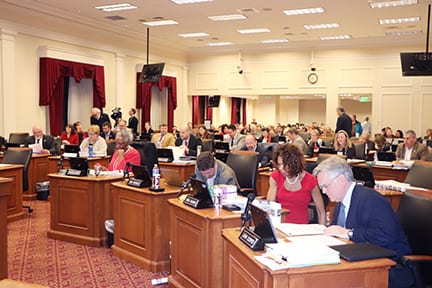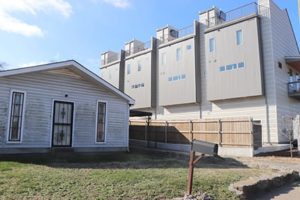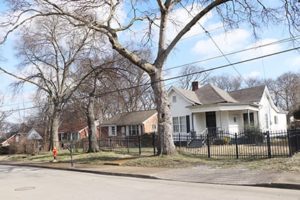by Peter White
EDITOR’S NOTE: The communities and organizations comprising the Diverse Elders Coalition are well aware of how the affordable housing crisis is hitting older Americans. Only last year, for instance, a UCLA study showed that three-quarters of California’s lower-income seniors who rend are being burdened by rising rental rates. The crisis, though, isn’t only being felt on the coasts. The following article is part of an investigative series for the Tennessee Tribune that unearthed trouble in Nashville. Veteran reporter Peter White produced this series on gentrification in “Music City” with support from the Journalists in Aging Fellows Program of the Gerontological Society of America, the Journalists Network on Generations and The Commonwealth Fund. The full series is a cross-generational case study, including more positive examples from other cities. Also see:
- Part 1: “What’s Killing Nashville’s Black Neighborhoods?”
- Part 3: “Nashville Next: Where’s the Beef?” on the city’s 25-year development plan; and
- Part 4: “Building Safety-Net Housing in Shark-Infested Waters”

At its February 5 meeting, the Nashville City Council deferred a bill that could put $40 million into the Barnes Fund to build more affordable housing.
The Nashville building boom started with a big government construction project. The Music City Convention Center broke ground in March 2010 and opened in May 2013. Since then, development has transformed properties downtown, south of Broadway and in the Gulch.
In East Nashville and on the west side in the Nations, gentrification has hit Nashville’s working-class neighborhoods hard. Charlotte Avenue from the Capitol to Sylvan Park and now the area around Clifton Ave from Swetts to 25th Ave. N. is starting to look like West Los Angeles.
“We don’t want that and we don’t need it,” said Tonya Wade-Moody. She has lived on the 700 block of 26th Ave. N. for 20 years. She raised her children there. She doesn’t like what’s happening to her neighborhood.
David Swetts thinks the remaking of the area will be a good thing. So does Reverend Enoch Fuzz of the Corinthian Baptist Church on 33rd Avenue N. He told the City Council the projects on 26th Ave N and 27th Ave N. will reduce crime in the neighborhood.

This is what it looks like when new construction replaces older single-family homes.
Perhaps, but this transformation has a social price. Older black homeowners are expendable in the new wave of development that is hitting North Nashville like a tsunami. It is wiping out dozens of single-family homes in the black district around Fisk University, Nashville General Hospital, Meharry Medical College and Tennessee State University. They are all black institutions with storied histories that go back more than a century. The community that gave rise to them is being fractured and dispersed.
How Zoning Gets Changed
If you want to build somewhere you have to get a permit from the Planning Department. The community plan designates zoning. If it calls for single-family homes and the builder wants to build one, then getting a permit is easy.
If you want to build something else, you must get a variance and make a good case to change the zoning to allow it. Developers work with planning staffers who review projects and then recommend approval to the Planning Commission. Sometimes they approve with conditions which the developer must live with. It may not be exactly what he wants.
If a builder wants to do something that the Community Plan does not allow, he can ask the commission to change the plan. And planning staffers often help builders do that. Last
December, at a Planning Commission meeting, eight of the 45 projects were proposals to change the plan to suit the builder.
When a developer wants a zoning change, the Nashville Next plan calls for community engagement and that usually means at least one meeting to sell the project to the neighbors. After Wade-Moody showed District 21 Councilman Ed Kendall her petition opposing the projects in her neighborhood, he organized a meeting at Mt. Zebo Baptist Church and told her to bring people who opposed the development.
“I will submit that several people who attended that meeting were in support of it, ones who spoke anyway,” Kendall told the council.
But the meeting called at Mt. Zebo to get community input was a farce, according to Renee Dennis. She lives across the street from Wade-Moody and felt insulted when Kendall suggested that nobody should want to live in a poor neighborhood.
“That comment was insulting to people who own homes in this area,” Dennis said. She has two elderly neighbors who also own their homes. “They may not make $50,000 a year but their homes are now worth $70-$100,000 more because of the development that has already taken place,” she said.
Development Can Bring Displacement
Dennis understands that rising land prices is a double-edged sword. Still, somehow, she wants to preserve the neighborhood’s single-family homes. “The more development they want to add will basically displace them eventually,” she said.

Single-family homes line one side of the 700 block of 26th Ave. N.
“I know people don’t like change,” Kendall said. He told the neighbors that the project’s approval was a foregone conclusion. “So, when you get up to speak have something positive to say,” he said.
That really got her back up. Dennis and her neighbors universally opposed the project and only had negative things to say about it so they didn’t say much at all. “We weren’t saying ‘don’t build here’. We’re saying build the same kind of homes so the elderly people who already live here can afford it,” she explained. Unless residents organize to stop City Hall from lying in bed with speculators, that isn’t going to happen.
When councilmembers bring a developer’s proposal to the Planning Commission, they are essentially endorsing it and asking for its approval. If nobody is there to object, the commissioners approve it on their consent agenda. Then the project goes before the City Council for the first of three readings and a public hearing. But the hearing is pretty much all for show.
The first hour or two of a typical city council meeting is taken up with bills to change the zoning on various properties around town. There are always a lot of them and the process is a bit like George Orwell’s Animal Farm because it’s is all about manufacturing consent.
The councilperson who is sponsoring a bill asks Vice-Mayor Jim Shulman to open a public hearing on their re-zoning bill. Shulman asks if anybody in the audience wants to speak in favor. Then he asks if anybody wants to speak against a particular proposal. “Seeing none, I declare the public hearing closed,” says Shulman and slams his gavel down. As Shulman moves through dozens of bills on the agenda, members start to doze. If they are lucky and things go quickly, they will get home before 10 pm.
Councilmembers support each other’s re-zoning bills as a matter of “Councilmanic Courtesy”. Members trust that their colleague has brought all the stakeholders into a conversation which resulted in some consensus. Thus, the outcome is pre-ordained although public hearings are held to give people three minutes at the microphone. That at least looks like democratic process even if it isn’t.
Regarding Kendall’s two bills for multi-family construction along Clifton Ave, he said the mixed development would bring 163 jobs, a grocery store, and that 20 percent, or about 12 units, would sell between $100,000-$250,000. “That’s unusual,” said Kendall and urged the bill’s passage.
Tonya Wade-Moody took her allotted time and spoke from the heart. So did L.D. McLemore who told the council, “It’s wrong, wrong, wrong.” Their impassioned pleas didn’t make the slightest difference to the outcome. The council voted unanimously to approve Kendall’s two bills.
2008 Housing Collapse and How Wall St. Keeps Stealing Dream Owning a Home
Nashville’s unprecedented growth cannot be explained without understanding the crash of the housing market which preceded it. Lehman Brothers, the nation’s fourth-largest investment bank, filed for bankruptcy Sept. 15, 2008. It was the largest business failure in U.S. history. Lehman’s collapse in New York sent shock waves as far as Nashville and beyond. Eight trillion dollars of housing wealth disappeared overnight sending the country into a deep recession.
A 2010 Center for Responsible Lending study found minority communities had significantly higher foreclosure rates than their white neighbors. Research showed minority borrowers were more likely to receive subprime loans during the boom with higher monthly payments and quicker defaults once the housing bubble burst.
“Millions lost their homes and jobs. Even a decade later, by some measures, most notably prime-age employment rates, the labor market has still not recovered,” wrote noted economist Dean Baker recently in a research paper for the Center for Economic and Policy Research in Washington.
‘Liar Loans’ and the Housing Bubble
In the run-up to the crash, investors bought entire blocks of new homes and then sold them to first-time homebuyers. Too many people were moving into those homes with so-called NINJA loans (No Income, No Job or Assets). In 2006, the National Realtors Association released a report showing that almost half of first-time homebuyers in 2005 had down payments of zero or less.
Overbuilding inevitably led to falling home prices and that meant getting into a new house was like buying a new car that loses 10 percent of its value the minute you drive it off the lot. The value of a new home dropped as soon as a buyer signed a “liar loan.”
“These price declines meant that millions of people were underwater in their mortgages even before Lehman Brothers collapsed,” Baker wrote. Then in 2008, the housing bubble burst and the stock market crashed.
Vacancy rates peaked in 2010 and that same year foreclosures peaked at 2.9 million. According to the Center on Budget and Policies Priorities, 8.7 million people lost their jobs between 2008-2010 and many could no longer pay their mortgages. According to ATTOM, a real estate database, there were about 30,000 bankruptcy filings in Nashville between 2008-2010.
Housing experts say minority communities generally have higher unemployment rates and black and Latino borrowers have fewer financial resources to fall back on than whites. In short, when people of color lost their homes, they were essentially broke.
Thanks to a federal bailout banks weathered the financial crisis. When the housing bubble burst, they dumped or wrote off their toxic assets. At bank sales or auctions, speculators and big Wall St. investors scooped up foreclosed homes for pennies on the dollar. And then they waited for the housing market to rebound. What was a tragedy for many became an opportunity for some.
“Private equity firms bought foreclosed single-family homes in bulk after the crisis and formed real estate investment trusts like Invitation Homes and American Homes 4 Rent to rent them out,” wrote Jeff Andrews recently for the real estate site Curbed.com. Michael Leidel, a real estate analyst with Metrostudy.com, says that happened and is still happening in Nashville.
According to Tennessee State University professor Dr. Ken Chilton, four Wall St. firms have bought 5500 single-family homes in Davidson and surrounding counties and turned entire neighborhoods into rental property. When that happens, people who own or are paying off a mortgage no longer live in a community of homeowners because too many have been sold to an investment firm that charges high rent but isn’t around to fix the plumbing.
A first-time homebuyer who needs a mortgage can’t compete with a Wall Street firm that pays cash. This trend started when the housing bubble burst in 2008. It accelerated in 2010 when banks started to lend out the cash they had been sitting on.
They were restrained from their worst impulses by the 2010 Dodd-Frank Wall St. Reform and Consumer Protection Act, but that didn’t stop speculators from buying up real estate in neighborhoods like North Nashville. That same year two events occurred in Nashville that triggered a massive building boom in Music City. One was the ground-breaking of the new convention center and the other was a massive flood.
The opinions expressed in this article are those of the author and do not necessarily reflect those of the Diverse Elders Coalition.
